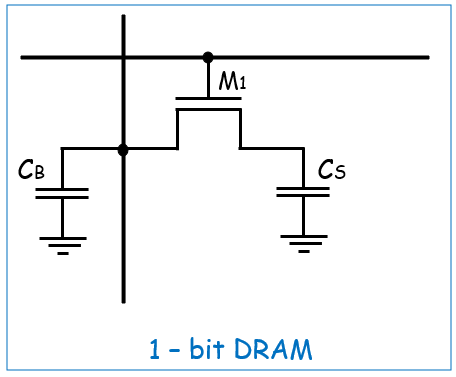- Volatile memory is a type of memory that loses its stored data when power is turned off or lost. Examples of volatile memory include Static Random Access Memory (SRAM) and Dynamic Random Access Memory (DRAM). It is retained only temporarily while the device is powered on, making it suitable for temporary storage of data that is actively processed by the CPU and doesn’t need to be retained when the device is powered off, such as program instructions and transient data.
- While volatile memory is fast and crucial for primary memory (RAM) in computers, it’s not used for long-term storage of sensitive data since the data is lost when power is interrupted.
- Dynamic RAM (DRAM): Dynamic random-access memory (DRAM) stores data using capacitors within an integrated circuit. Each bit of data is represented by the charge state of a capacitor, which can be either charged (representing a logic “1”) or discharged (representing a logic “0”).

- The basic structure of a 1-bit DRAM circuit consists of a capacitor (CS) storing the data for the cell, with Read/Write access provided via a transistor (M1). Capacitance for each bit line per length is denoted by CB. These cells are arranged as an array on a silicon wafer, with columns representing individual bits and rows representing words. The address of a cell is determined by the intersection of a bit and a word line.
- To access data in DRAM, each bit in the column is activated via its corresponding transistor, and to write data, the row lines contain the desired state for the capacitors. During read operations, a sense amplifier detects the charge on the capacitor. If the charge is above 50%, the data is interpreted as a logic “1”; otherwise, it’s interpreted as a logic “0”.
- One challenge with DRAM is that capacitors do not retain their charge indefinitely due to minor charge leakage. To overcome this, data must be periodically refreshed. During refresh cycles, the data is sensed and then re-written, ensuring that any charge leakage is compensated for and data integrity is maintained.
- Despite this limitation, DRAM offers several advantages. The simple structure of each memory cell, requiring only one transistor and one capacitor, allows for high-density memory arrays and lower cost per bit compared to other memory technologies. Additionally, the small size of transistors and capacitors enables billions of them to fit on a single memory chip.
- However, it’s important to note that DRAM is a dynamic memory technology and dissipates significant power, particularly during refresh operations.
- Dynamic Random Access Memory (DRAM) comes in several types, each offering different features and capabilities. Here are some common types:
- Synchronous DRAM (SDRAM): SDRAM synchronizes with the system clock, enabling faster data access compared to asynchronous DRAM. Widely employed in computing systems like desktops, laptops, and servers due to its efficiency and high speed.
- Double Data Rate SDRAM (DDR SDRAM): DDR SDRAM transfers data on both the rising and falling edges of the clock signal, effectively doubling the data transfer rate compared to SDRAM. It exists in various generations such as DDR, DDR2, DDR3, DDR3L, DDR4, DDR4L, and DDR5, each offering improved performance and energy efficiency.
- Graphics DDR (GDDR): Optimized for graphics processing units (GPUs) and video game consoles, GDDR provides higher bandwidth and lower latency than standard DDR SDRAM. Ideal for demanding graphics applications.
- Low-Power DDR (LPDDR): LPDDR is engineered for mobile devices like smartphones, tablets, and portable gaming consoles. It consumes less power and operates at reduced voltage levels compared to standard DDR SDRAM, extending battery life in mobile devices.
- Error-Correcting Code (ECC) DRAM: ECC DRAM integrates additional circuitry for error detection and correction, enhancing data integrity and system stability, particularly in critical applications.
These DRAM variants cater to diverse computing needs, offering a range of performance, efficiency, and reliability features to meet specific requirements across various industries and devices.
- Static RAM(SRAM): Static random-access memory (SRAM) is a type of semiconductor memory that utilizes bi-stable latches or flip-flops to store one bit of data. While SRAM retains data as long as power is supplied, the data is eventually lost when the cell loses power.

- A typical SRAM cell, as shown in above figure, consists of six transistors (often referred to as a 6T-SRAM cell). These transistors are organized into access transistors (M5 and M6), pull-up transistors (M2 and M4), and pull-down transistors (M1 and M3). SRAM operations include hold, read, and write operations:
- Hold Operation: During hold operation, both access transistors are turned OFF, and SRAM maintains its current state due to latching.
- Read Operation: During read operation, the two bit lines must be recharged to VDD, and the access transistors are turned on. The sense amplifier detects the potential difference between the bit lines, determining the stored data as logic one or logic zero.
- Write Operation: In the write operation, data is written onto the memory by applying it to the bit line while the access transistors are in the on state.
- Due to its high speed, SRAM cells are commonly used as cache memories and in servers’ main memory.
- This makes SRAM advantageous for applications requiring rapid access to data without the overhead of refresh cycles, contributing to its widespread use in high-performance computing systems.